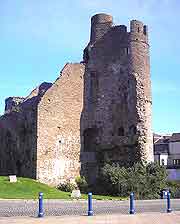Swansea History Facts and Timeline
(Swansea, West Glamorgan, South Wales, UK)

Swansea has a rich history that extends from being a Bronze Age settlement to one of the largest coal ports in Wales. The first written evidence we have of a settlement here is based on records of Viking forays in the Swansea Bay area during the 9th and 10th centuries.
Indeed, Swansea's name is thought to derive from the Norse word 'Swein'. 'Sweins ey' means Swein's Island. It's thought that the island in question was somewhere in the River Tawe estuary.
From Medieval Times to the 17th century
When the Normans arrived in Swansea in the 11th century, they found nothing more than a small town. A castle was quickly built, first in wood and then later in stone. Under the protection of this stronghold, the town expanded. In the late 12th century, it was given a charter that gave the townsfolk certain rights.
During the Middle Ages period of history, Swansea was frequently under attack from Welsh forces, including the rebellion of Owain Glyndwr in 1402. Like many medieval Welsh towns, those who lived and worked in Swansea were involved in the wool trade or leather making. It's likely that shipbuilding was also carried out here. Administration of the town was by a 'Portreeve' and some 12 aldermen.
By the 17th century, Swansea had become a much larger town. The coal mining industry was flourishing and the port was ideally placed for exports. By 1682, a grammar school had been set up, along with a bank and theatre. It was a far cry from the small town that existed only a century earlier.
Georgian History to the Present Day
In the 18th century, Swansea was successful on two fronts. First, it took on the role of seaside resort. In fact, it was known as the 'Brighton of Wales'. Whilst it didn't have quite the same royal connections as many other seaside resorts of this era, it did manage to attract large numbers of tourists. The demand for accommodation led to the building of some fine Georgian terraced housing in parts of the town, including those now found at Somerset Place, Gloucester Place and Cambrian Place.
Second, the metal working industry took off here. The first copper works were built as far back as 1717. However, it wasn't until the early 19th-century that larger copper works were set up and the town became known as 'Copperopolis'. By the 1840s, the company owned by Vivian and Sons was the largest copper exporter in Britain. The town built for the workers was originally called Trevivian or Vivianstown - nowadays, we know it as Hafod. By 1886, some 3,000 people were employed in the industry. In 1983, the Swansea-based novelist Iris Gower wrote several books that were based on the city's copper heritage.
The port at Swansea quickly grew to keep up with demand. In 1852, the North Dock was built. Then came the South Dock and, in 1881, the Prince of Wales Dock. Urban improvements followed too, including a general hospital and a public library. Victoria Park was opened in 1887, offering Swansea's workers an opportunity to enjoy open-air recreation.
During the first part of the 20th century, Swansea continued to prosper. However, it was to suffer greatly during World War Two, when bombing raids led to the destruction of much of the centre. Post-war building projects included new industrial estates, with city status arriving in 1969. Whilst the city's shipbuilding industry did finally succumb to competition, it nevertheless remains a busy port today.
 Swansea has a rich history that extends from being a Bronze Age settlement to one of the largest coal ports in Wales. The first written evidence we have of a settlement here is based on records of Viking forays in the Swansea Bay area during the 9th and 10th centuries.
Swansea has a rich history that extends from being a Bronze Age settlement to one of the largest coal ports in Wales. The first written evidence we have of a settlement here is based on records of Viking forays in the Swansea Bay area during the 9th and 10th centuries.